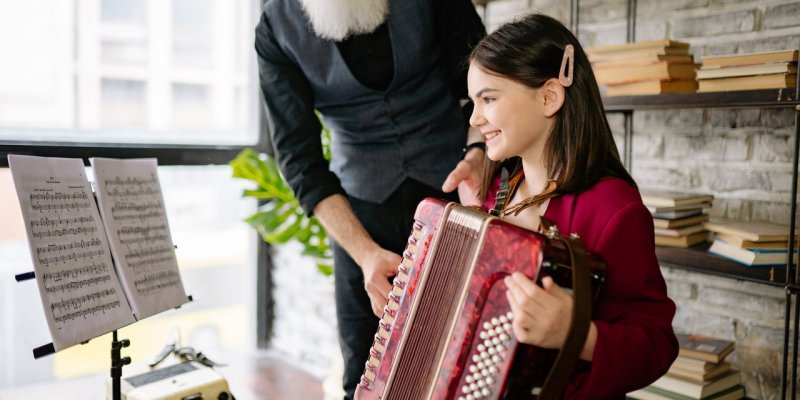
You've probably seen an instrument that would fit the description of a squeeze box well, but you may be surprised at how many different kinds of instruments really fall under this colloquial term.
In order to qualify as a squeezebox, the instruments need to be hand-held, driven by bellows, and a free-reed aerophone. The handheld part is pretty self-explanatory, but bellows and free-reed aerophones aren't known by most.
Free-reed aerophones are instruments that get their sound from air passing a vibrating reed. Reeds are simply thin strips of material made of steel, brass, or cane.
To be driven by bellows is to be driven by a device that is crafted to create a strong blast of air. While these instruments are now more commonly driven by bellows, this is just a supplement for the air from a person's mouth.
The more well-known types of squeeze box instruments belong to the family of accordions. These types of instruments use steel or brass as the material for the reeds that vibrate to create the sound.
There are many variations of these instruments, and I'll describe the most common that people worldwide like to play.
While some people assume that accordions only have piano keys, there are many that allow accordion players to play with buttons instead. The patent for this instrument was made in the mid-1800s, so it's relatively new!
There are two types of button accordions: diatonic and chromatic.
Diatonic button accordions are more common, and each row of buttons is in order of a major scale. For chromatic button accordions, they are arranged chromatically.
A piano accordion has a portable right-hand keyboard similar to a piano or an organ and was also invented in the mid-1800s.
It's currently the official instrument of San Francisco and also has a bass variation that plays an octave lower than the original instrument.
These types of accordions are very similar to piano accordions, but they produce a sound that mimics the sound of an accordion on digital playback. It's almost like this type doesn't really fit the category since it doesn't use a reed!
The digital side of things allows some of these models to do a lot of cool sound effects that a traditional instrument couldn't pull off, especially when it comes to amplifying.
Very similar to the piano accordion, the country of Georgia has a variation of this instrument called the Georgian Garmoni or the Georgian accordion, which can be diatonic or chromatic that plays traditional music.
Surprise, surprise, this version was also likely to be made in the mid-1800s!
These types of squeeze box instruments are similar to accordions, but they have buttons or keys on both sides instead of just one side.
Concertinas are free-reed instruments as well, and they were first invented in the early 1800s. Funny enough, they were developed independently in Germany and in England around the same time.
This type of concertina is a fully chromatic instrument with cool buttons in a rectangular shape on either side. It's actually the earliest version of any concertina, as it was invented in 1829.
It's unique in the way that it requires both hands to play out one full scale that's divided evenly.
German concertinas are usually larger than their English counterparts, usually more square, and use a different long-plate style of reeds.
One popular version is called the Chemnitzer Concertina, with many buttons on either side and comes with straps to allow ease of access for the player's hands.
Another German invention is the Bandoneon, which spread in popularity to Argentina and also includes straps.
This variation is a hybrid between English and German concertinas.
They often have the same 20 buttons that German concertinas have, with concertina reeds instead of long-plate reeds, independent pivots for each button, and hexagon-shaped ends.
Duet concertinas are not as common as the other versions that I've mentioned above. Unlike the Anglo concertina, these instruments play the same note on the push and pull of the bellows that create the air.
Unlike the English version, the lower notes are on the left, and the higher notes are on the right.
Related Post: How To Write A Country Song - 10 Tips To Make A Hit
Begin by mastering fundamental techniques. Learn how to hold the instrument, position your hands, and navigate the keyboard or buttons.
Practice producing clear and even tones while maintaining control over the bellows. Focus on playing scales, simple melodies, and basic chords to develop dexterity and coordination.
Learning music theory can greatly enhance your understanding and proficiency on a squeezebox instrument. Familiarize yourself with concepts such as scales, chords, key signatures, and rhythm.
This knowledge will allow you to read sheet music, play by ear, and improvise more effectively. It will also aid in transposing music to different keys.
The bellows are a crucial element of squeezebox instruments. Understanding how to control the bellows is essential for achieving expression and dynamics in your playing.
Practice bellows control exercises such as long sustained notes, crescendos, and diminuendos. Experiment with different speeds, directions, and pressures to produce a range of tonal effects.
Consider taking lessons from a qualified instructor who specializes in squeezebox instruments. They can provide valuable guidance, teach you proper technique, and offer personalized feedback.
Also, make a regular practice routine to develop muscle memory, improve your playing skills, and build your repertoire. Consistency and dedication are key to progressing on any instrument.

As a session singer, writer, and producer that has worked with over 300 clients to provide high-quality jingles, singles, and features, Yona spends her time creating and marketing new music and helpful resources for creators. Check out Yona’s latest releases on her Spotify, her Youtube and share if you like it!
If you are in need of singer, songwriter or song producer services, see what Yona Marie can offer you on her services page.